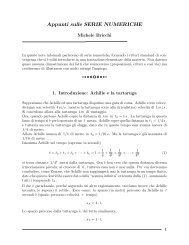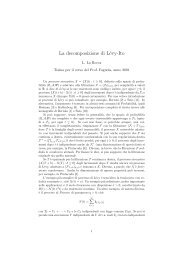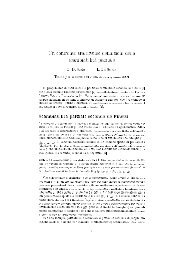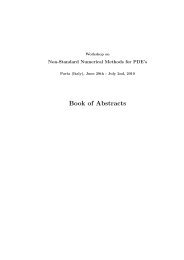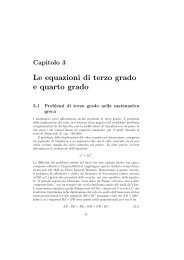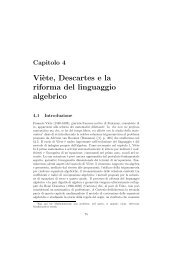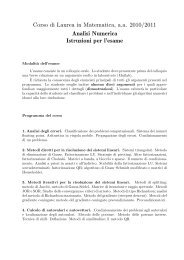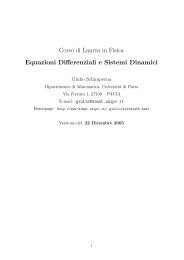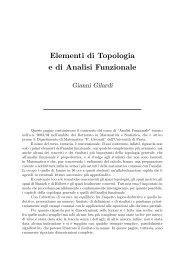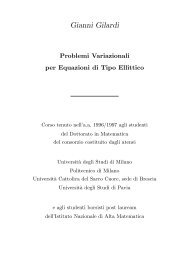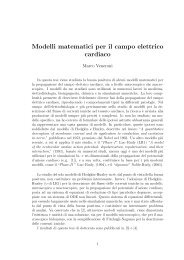- Page 1 and 2:
Gianni Gilardi Analisi Funzionale (
- Page 3 and 4:
11 Funzioni convesse . . . . . . .
- Page 5 and 6:
Capitolo 1 Norme e prodotti scalari
- Page 7 and 8:
Norme e prodotti scalari 2.7. Propo
- Page 9 and 10:
Norme e prodotti scalari 3.8. Propo
- Page 11 and 12:
Norme e prodotti scalari Presentiam
- Page 13 and 14:
Norme e prodotti scalari 3.22. Esem
- Page 15 and 16:
Norme e prodotti scalari 4.12. Coro
- Page 17 and 18:
Norme e prodotti scalari 5.8. Esemp
- Page 19 and 20:
Norme e prodotti scalari Dimostrazi
- Page 21 and 22:
n=1 Norme e prodotti scalari 5.30.
- Page 23 and 24:
Norme e prodotti scalari Supponiamo
- Page 25 and 26:
Norme e prodotti scalari 5.45. Aper
- Page 27 and 28:
Norme e prodotti scalari Dimostrazi
- Page 29 and 30:
Norme e prodotti scalari da p (dipe
- Page 31 and 32:
5.60. Osservazione. Lo spazio W p N
- Page 33 and 34:
asta scegliere M = � Norme e prod
- Page 35 and 36:
6. Alcune costruzioni canoniche Nor
- Page 37:
Norme e prodotti scalari del prodot
- Page 40 and 41:
Capitolo 2 Vedremo più tardi che l
- Page 42 and 43:
Capitolo 2 associa la N -upla delle
- Page 44 and 45:
Capitolo 2 3. Completamenti di spaz
- Page 46 and 47:
Capitolo 2 tale affermazione svilup
- Page 48 and 49:
Capitolo 2 in W k,p (Ω) . In part
- Page 50 and 51:
Capitolo 2 che controllare la densi
- Page 53 and 54:
Capitolo 3 Operatori e funzionali R
- Page 55 and 56:
Operatori e funzionali 1.11. Defini
- Page 57 and 58:
Operatori e funzionali Ma Ω + (x0
- Page 59 and 60:
2. Lo spazio duale Operatori e funz
- Page 61 and 62:
Operatori e funzionali Si noti che,
- Page 63 and 64:
Operatori e funzionali Dunque la fu
- Page 65:
Dividendo per �(v, w)� otteniam
- Page 68 and 69:
Capitolo 4 di estremo inferiore esi
- Page 70 and 71:
Capitolo 4 1.19. Esercizio. Siano H
- Page 72 and 73:
Capitolo 4 e denotiamo con T l’in
- Page 74 and 75:
Capitolo 4 Dunque, in ipotesi di un
- Page 76 and 77: Capitolo 4 ove α0 = (ℓ p +1) −
- Page 78 and 79: Capitolo 4 1.35. Esempio. Storicame
- Page 80 and 81: Capitolo 4 2.7. Lemma. Siano H uno
- Page 82 and 83: Capitolo 4 2.13. Teorema. Siano H u
- Page 84 and 85: Capitolo 4 2.20. Proposizione. Sian
- Page 86 and 87: Capitolo 4 3.4. Teorema. Sia V uno
- Page 88 and 89: Capitolo 4 Per meglio chiarire la d
- Page 90 and 91: Capitolo 4 3.17. Esercizio. Si pong
- Page 92 and 93: Capitolo 4 4.1. Definizione. Sia V
- Page 94 and 95: Capitolo 4 4.18. Esercizio. Siano f
- Page 96 and 97: Capitolo 4 5.3. Osservazione. Senza
- Page 98 and 99: Capitolo 4 formula aε(u, v) = (u,
- Page 100 and 101: Capitolo 4 Ma ciò significa che (1
- Page 102 and 103: Capitolo 5 Dimostrazione. Consideri
- Page 104 and 105: Capitolo 5 2.2. Applicazione. Se
- Page 106 and 107: Capitolo 5 Applicando il Corollario
- Page 108 and 109: Capitolo 5 come l’identità. Ciò
- Page 110 and 111: Capitolo 5 4.6. Definizione. Sia V
- Page 112 and 113: Capitolo 5 Segnaliamo che, in situa
- Page 114 and 115: Capitolo 5 Per comodità diciamo ch
- Page 116 and 117: Capitolo 5 5.12. Teorema. Sia V uno
- Page 118 and 119: Capitolo 5 6.9. Osservazione. Il ca
- Page 120 and 121: Capitolo 5 estrarre una sottosucces
- Page 122 and 123: Capitolo 5 8.2. Osservazione. Natur
- Page 124 and 125: Capitolo 5 9.3. Definizione. Siano
- Page 128 and 129: Capitolo 5 Se poi B(x0) = {Bn : n =
- Page 130 and 131: Capitolo 5 chiuso epi f , troviamo
- Page 132 and 133: Capitolo 5 Dimostrazione. L’epigr
- Page 134 and 135: Capitolo 5 dato che 1/(p − 1) = q
- Page 136 and 137: Capitolo 5 12. Il sottodifferenzial
- Page 138 and 139: Capitolo 5 12.12. Definizione. Sian
- Page 140 and 141: Capitolo 5 12.19. Esempio. Sia V un
- Page 142 and 143: Capitolo 5 Fissiamo ora y ∈ D(ϕ)
- Page 144 and 145: Capitolo 5 è la funzione data prop
- Page 146 and 147: Capitolo 5 Osserviamo che, pur di e
- Page 148 and 149: Capitolo 5 12.27. Osservazione. L
- Page 151 and 152: Capitolo 6 Spazi riflessivi Nel cap
- Page 153 and 154: Spazi riflessivi norma | · |pk (di
- Page 155 and 156: 2.3. Teorema. Se V è riflessivo, o
- Page 157 and 158: Capitolo 7 I teoremi fondamentali d
- Page 159 and 160: Inoltre w è di classe C 1 e per og
- Page 161 and 162: I teoremi fondamentali di Banach 2.
- Page 163 and 164: I teoremi fondamentali di Banach Il
- Page 165 and 166: I teoremi fondamentali di Banach Di
- Page 167 and 168: I teoremi fondamentali di Banach 3.
- Page 169 and 170: I teoremi fondamentali di Banach si
- Page 171 and 172: I teoremi fondamentali di Banach 5.
- Page 173 and 174: I teoremi fondamentali di Banach 6.
- Page 175 and 176: I teoremi fondamentali di Banach ov
- Page 177 and 178:
I teoremi fondamentali di Banach 7.
- Page 179 and 180:
I teoremi fondamentali di Banach Si
- Page 181 and 182:
I teoremi fondamentali di Banach 7.
- Page 183 and 184:
I teoremi fondamentali di Banach Di
- Page 185 and 186:
I teoremi fondamentali di Banach 7.
- Page 187 and 188:
8. Un problema di tipo ellittico I
- Page 189 and 190:
I teoremi fondamentali di Banach ch
- Page 191 and 192:
I teoremi fondamentali di Banach Al
- Page 193 and 194:
I teoremi fondamentali di Banach Se
- Page 195:
I teoremi fondamentali di Banach pu
- Page 198 and 199:
Capitolo 8 1.5. Osservazione. Suppo
- Page 200 and 201:
Capitolo 8 Consideriamo ora la conv
- Page 202 and 203:
Capitolo 8 2.9. Esercizio. Si dimos
- Page 204 and 205:
Capitolo 8 entrambe invarianti per
- Page 206 and 207:
Capitolo 8 Mettiamo in guardia il l
- Page 208 and 209:
Capitolo 8 Dimostrazione. Per dimos
- Page 210 and 211:
Capitolo 8 della base standard asso
- Page 212 and 213:
Capitolo 8 Si noti che la convergen
- Page 214 and 215:
Capitolo 8 4.15. Esercizio. Verific
- Page 216 and 217:
Capitolo 8 4.25. Esercizio. Si cont
- Page 218 and 219:
Capitolo 8 Gli esempi successivi ri
- Page 220 and 221:
Capitolo 8 Dimostrazione. Osserviam
- Page 222 and 223:
Capitolo 8 per cui possiamo prender
- Page 224 and 225:
Appendice cioè dicendo che A è un
- Page 226 and 227:
Appendice 1.16. Definizione. Uno sp
- Page 228 and 229:
Appendice 2.5. Definizione. Uno spa
- Page 230 and 231:
Appendice 2.21. Osservazione. Ma si
- Page 232 and 233:
Appendice 2.32. Corollario. Siano
- Page 234 and 235:
Appendice Capitolo I 3.5. Da |�x
- Page 236 and 237:
Appendice Capitolo II 1.7. Sia v
- Page 238 and 239:
Appendice Capitolo III 1.8. Se f =
- Page 240 and 241:
Appendice Capitolo IV 1.8. Denotiam
- Page 242 and 243:
Appendice 4.16. Fissato (a, b) sian
- Page 244 and 245:
Appendice misure siano finite). All
- Page 246 and 247:
Appendice Capitolo VII 3.12. L’ap
- Page 248 and 249:
Appendice Capitolo VIII 1.8. Vediam
- Page 250 and 251:
Appendice successione {vnk } tale c
- Page 252:
Appendice Precisamente la prima val



